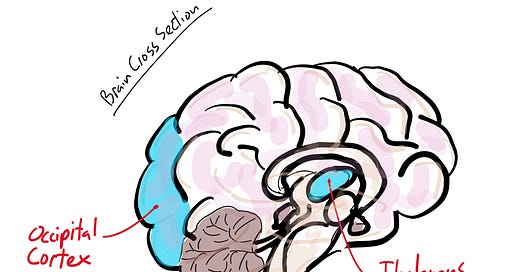Research Hit: Discovery of Brain Mechanism for Overcoming Fear
New research finds a pathway and mechanism leads to natural fear extinction
Fear extinction sounds great - is this really possible?
Well, yes we have all experienced this in many ways. We are all born with some natural fears such as from loud noises and fast approaching objects - these are “hard-wired”.
However, with time and experience we can, and do, overcome these, at least in some circumstances. Think of the joy people experience with loud fireworks, not fear (in contrast to many dogs), or of a baseball batter hitting a fast moving object coming almost directly at them.
Isn’t that just getting use to something?
Yes, but what is precisely the mechanism because if we can understand this better, we may be able to target various fear disorders.
What is happening in the brain then?
This research by Sara Mederos et al., of the Sainsbury Wellcome Centre in the UK, found that two regions are critical to this but, and this is important, their role changed with learning.
Go on!
They simulated this fear learning in mice by using an increasing size shadow on the ground which would normally be associated with a flying predator coming to gobble them up.
There is an interplay with the visual cortex, kind of obvious, and a region deep in the brain in the thalamus - called the ventrolateral geniculate nucleus (vLGN) if you want to get technical.
In the learning situation the visual cortex communicated to the vLGN to simulate this fear response. But as this was repeated multiple times and no predator emerged the mice started extinguishing the fear response. If the visual connection was blocked it returned.
This is as we would expect but what was surprising is that this was reversed when the behaviour was learned.
How so?
Well it reversed - the visual part of the brain was no longer needed to suppress the fear response. Actually it was reversed - the learning in the vGLN changed the neurotransmitters released and this suppresses the visual cortex. The opposite to what we would consider i.e we expect the cortex to communicate to the vGLN not the other way around.
And what does this mean?
Quite a lot. Firstly we know that cortical, and/or cognitive, processes help with learning a new fear response - think of saying to yourself “this is not dangerous”. But once this is learned the response is saved deep in the brain and this is reversed.
That also means that if fear responses are “badly” saved, such as in PTSD, a cortical, cognitive, process may not solve the problem. You may know the fear is irrational but have no way to control it as it is working in reverse: bottom up and not top down.
And how to counter this
Too early to say at the moment. Maybe overlaying a similar more effective memory pattern - but as we now know the mechanism in mice this could be targeted with medication or a newly developed medication - but that will be a while.
You reported previously on a brain switch for fear - doesn’t this show that these fears are biological not psychological?
Yes, I reported on generalised fear last year and a particular biological switch in the brain. Remember everything is ultimately biological - if we think differently we are using different neurons and transmitters.
But good to have this knowledge and it will help, with time, to develop new interventions for these fear-based disorders.
Hopefully sooner than later!
Reference
Sara Mederos, Patty Blakely, Nicole Vissers, Claudia Clopath, Sonja B. Hofer.
Overwriting an instinct: Visual cortex instructs learning to suppress fear responses.
Science, 2025; 387 (6734): 682
DOI: 10.1126/science.adr2247





